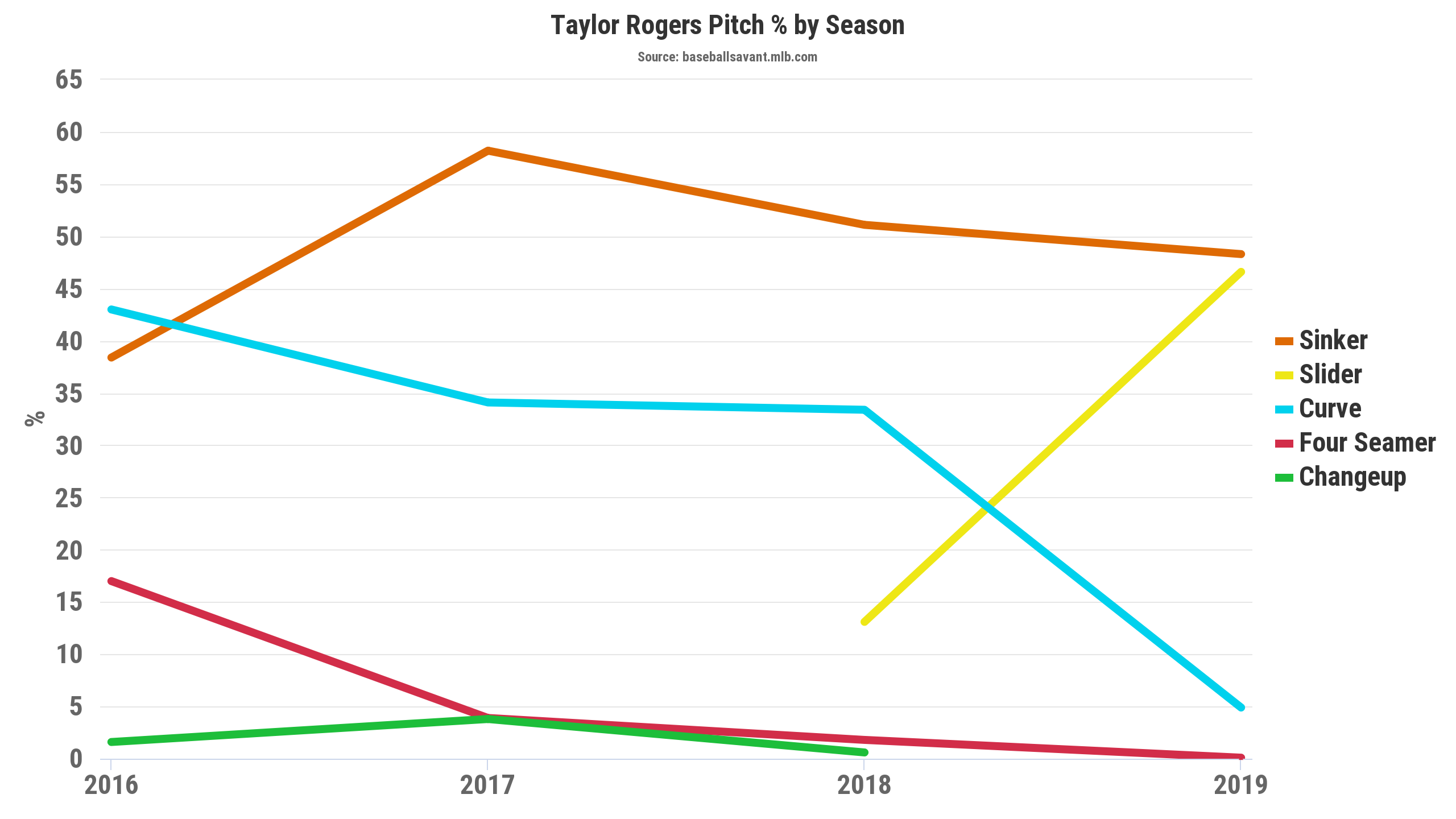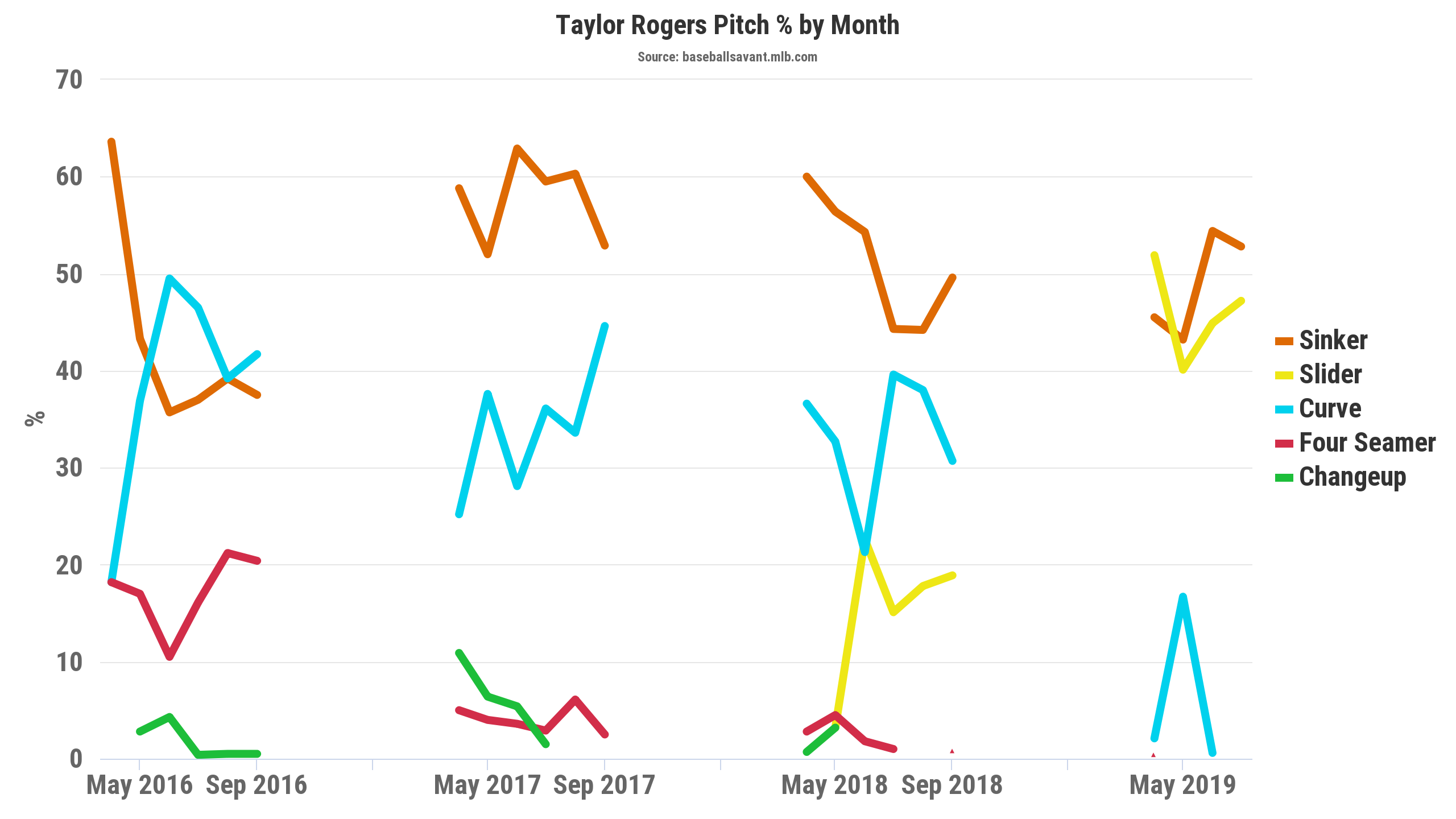One of the best things about baseball is how quickly things can change. A team can look bad for most of the season and then can rattle off 14 wins in 17 games and insert themselves back into the postseason hunt (looking at you, Giants). The way we look at certain players can quickly change. We’ve seen examples the past few years of players like J.D. Martinez, Max Muncy or Justin Turner who transformed their games to become some of the best players in baseball after being released by their former club, or already solid players like George Springer who make subtle adjustments and take their games to another level. One of the toughest things when evaluating players is trying to figure out if the strong performances are real.
Taylor Rogers is a good example of a pitcher who has made the necessary adjustments to improve his game. A relief pitcher for the Minnesota Twins, Rogers has been their primary closer for the better part of a month now, but I still feel like he’s too unknown. He has quietly been one of the best relief pitchers in baseball and yet he is still under 50% owned in ESPN leagues and while he is sitting at 70% ownership in Yahoo leagues, it is perhaps still too low, as he has posted this line so far this season:
| ERA | FIP | ERA- | FIP- | SIERA | K% | BB% | Saves | |
| Taylor Rogers | 1.92 | 2.62 | 42 | 57 | 2.72 | 31.0 | 3.8 | 15 |
Those numbers, combined with him being the primary closer for a good team, should make him one of the most sought after relievers for fantasy baseball purposes, but his ownership rates don’t seem to reflect that. He blew a save Sunday that saw him allow his first runs since June 22nd, and in the time between those two hard-luck outings, Rogers has rewarded owners with five saves—four of which have been for more than three outs—by shutting down opposing lineups and making it look easy. The highlight of that stretch was a 2.1 inning save against the Texas Rangers on July 6th that saw him strikeout five opposing Rangers in the seven-out span for the Twins. His ability to go multiple innings was what made him attractive to me to begin the season, but now he is doing it while also providing saves, which is a great combination.
Relievers are volatile though, so when a reliever comes out of nowhere and puts up good performances, it is reasonable to ask if it will stick. I present the following table to you:
| Name | Team | IP | K% | BB% | K-BB% | FIP | xFIP | wOBA |
| Liam Hendriks | OAK | 54.1 | 31.88 | 7.25 | 24.64 | 1.96 | 3.91 | .214 |
| Kirby Yates | SD | 67.1 | 41.29 | 5.68 | 35.61 | 1.96 | 2.29 | .233 |
| Ryan Pressley | MIN/HOU | 69.2 | 34.36 | 4.25 | 30.12 | 2.09 | 2.26 | .195 |
| Taylor Rogers | MIN | 73.1 | 32.50 | 5.36 | 27.14 | 2.28 | 2.96 | .217 |
| Brad Hand | CLE | 68.1 | 38.04 | 8.33 | 29.71 | 2.45 | 2.85 | .262 |
| Giovanny Gallegos | STL | 46.1 | 37.57 | 4.62 | 32.95 | 2.46 | 2.96 | .226 |
| Taylor Cole | LAA | 45.1 | 25.28 | 10.11 | 15.17 | 2.52 | 3.77 | .231 |
| Felipe Vazquez | PIT | 69.0 | 33.22 | 6.29 | 26.92 | 2.52 | 3.00 | .283 |
This table is showing the FIP leaders for relievers in the past 365 days with a minimum of 45 innings pitched. So what this shows us is that for the past year, Taylor Rogers has been the fourth-best relief pitcher in terms of FIP, beating out more well-known relief pitchers such as Aroldis Chapman, Will Smith and Josh Hader. In other words, I don’t think this is a fluke. If you’re still not convinced, there is legitimate proof that Taylor Rogers has made improvements and adjustments that are driving his success.
The biggest thing that is different with Taylor Rogers in the past year compared to previously in his career is his pitch mix. Take a look at this:

Yup, like a lot of successful pitchers, Rogers features a slider and is throwing it more often than ever, but what is really crazy is that prior to 2018, Rogers didn’t throw a single one. We can expand this to look his pitch mix by month and we see something even more interesting:

So, we see that Rogers introduced this slider about halfway through the 2018 season. It is pretty wild to see a pitcher start throwing a pitch for the first time in his career and do that on the fly in the middle of a season. I’d say it’s worked out for him, considering his splits pre-June 2018 are nothing special compared to his performance since:
| Time Frame | IP | ERA | FIP | xFIP | wOBA | K% | BB% | K-BB% |
| 1/1/2016-5/31/2018 | 138.1 | 3.84 | 3.68 | 3.79 | .308 | 22.2 | 7.3 | 14.9 |
| 6/1/2018-7/20/2019 | 92.2 | 1.65 | 2.35 | 2.86 | .226 | 32.2 | 4.8 | 27.4 |
That’s a pretty drastic change from about average to purely elite, and what really stands out is the ten-percent increase in strikeouts with a strong decrease in walks, which is not usually expected when a pitcher is striking out more hitters. The introduction of the slider to his repertoire has resulted in more success for Rogers because the pitch has helped him overcome his biggest weakness as a pitcher: right-handed hitters. As teams move away from specialized roles, like the ever-popular LOOGY (left-handed one-out guy) in the bullpen, pitchers have to be able to get hitters of both handednesses out. Rogers was always good at getting left-handed hitters out but really struggled to do so against righties. Here’s a table comparing Rogers’ performance against lefties to his performance against righties prior to June 2018:
| AVG | OBP | SLG | wOBA | Hard-Hit% | |
| vs LHH | .212 | .275 | .301 | .254 | 19.7 |
| vs RHH | .292 | .355 | .442 | .338 | 39.7 |
Right-handed hitters were hitting like Tommy Pham against Rogers prior to him introducing the slider, while left-handers were hitting like the 2019 version of Yonder Alonso. That’s a drastic-enough platoon split that it gets to be concerning. To continue to stick in the Majors in a meaningful role, Rogers had to make adjustments. Since introducing the slider in June 2018, he has been much better against right-handed hitters while also maintaining the same level of domination against left-handed hitters:
| AVG | OBP | SLG | wOBA | Hard-Hit% | |
| vs LHH | .158 | .232 | .167 | .190 | 16.7 |
| vs RHH | .202 | .246 | .343 | .247 | 37.2 |
Now that looks like a more complete pitcher who is capable of getting big outs in any situation. Introducing the pitch to give right-handed hitters a different look is one thing, but the slider itself is pretty lethal. It makes Mike Trout not look like the best player in baseball here:
And it still gives lefties fits, as demonstrated by Jake Bauers:
Hitters of any type aren’t having much success against his slider. Take a look at this table comparing his slider overall to the pitch’s results against each handedness:
| Split | Pitch% | K% | BB% | Whiff% | wOBA | xwOBA |
| Overall | 46.6 | 33.8 | 1.8 | 33.6 | .232 | .222 |
| vs LHB | 48.2 | 44.0 | 0.0 | 46.2 | .175 | .138 |
| vs RHB | 46.0 | 29.1 | 1.8 | 26.8 | .257 | .259 |
Neither side of the platoon seems to be having much success against the pitch. The .175 wOBA mark against his slider is one of the strongest among pitchers who throw a slider regularly. Also, the .232 wOBA on the pitch overall in 2019 is among the best in baseball and the pitch has a .199 wOBA against since 2018, also among the best in baseball. The pitch features strong horizontal movement and combined with his ability to control the pitch, Rogers all of a sudden has a weapon that he can go to get any type of hitter out with confidence as he continues to surge up leaderboards.
Adjustments are a necessary part of the game, as players can’t usually stick with what has always worked for them if they want to continue to perform at a high level. For Taylor Rogers, he was previously good enough to stick on the big league roster for the Minnesota Twins but didn’t always have sustained success. When he introduced a slider in mid-2018, his overall results began to improve and has shot all the way up to the top of the Twins’ reliever depth chart, getting the majority of the save opportunities for one of the better teams in baseball, which makes him attractive as a fantasy option. What also makes him a good fantasy option is that he gets a lot of saves that go more than three outs, as getting more high-quality outs is only a good thing for fantasy owners—out of the regular closers in baseball, only Josh Hader gets more outs during his saves than Rogers does.
A caveat to keep in mind is that the Twins are known to be interested in upgrading their bullpen by the trade deadline. If they acquire a proven closer like Will Smith, Kirby Yates or Ken Giles, it would be pretty logical to assume that the team moves Rogers back to the role he was in earlier this season when Blake Parker was closing the majority of the time for the Twins. While it would hurt his value from a saves perspective, it’s still comforting to know that Rogers will provide strong, quality appearances—often for more than one inning—and will continue to play a big role in the bullpen for the Minnesota Twins. Regardless, Taylor Rogers should remain a valuable piece as a relief ace, and is a pitcher who needs a little more love.
Featured Image by Justin Paradis (@freshmeatcomm on Twitter)


I dropped Blake Treinen for Rogers a few weeks ago…looking alright now.